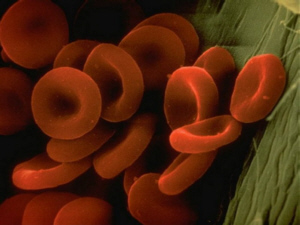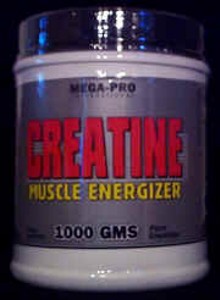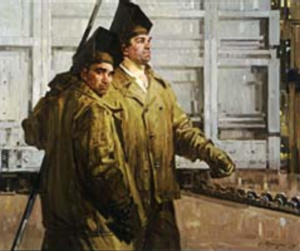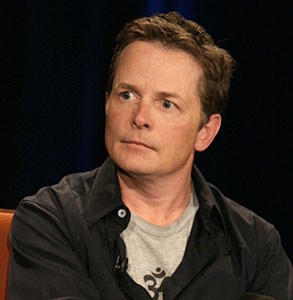|
APRIL
2009
����������������������������������������������������������������������������������������������������������������������������������������������������� 29th April 2009 - New research
THE ROLE OF IRON IN PARKINSON'S DISEASE
Results of a new Mayo Clinic study support an association between anemia
experienced early in life and the development of Parkinson's disease many years
later. The findings will be presented at the American Academy of Neurology
Annual Meeting in Seattle on April 30th 2009. Anemia was significantly more
common in Parkinson's Disease than in other people. For more information go to
the
News release.
 Anemia is
largely due to
insufficient hemoglobin, which transports oxygen in the
blood. The major constituent of hemoglobin is iron.� So if there is
insufficient iron, there will be a lack of hemoglobin. For more information go
to Anemia.
Iron is also essential for the formation of L-dopa, whose deficiency causes
Parkinson's Disease. The quantity of L-dopa formed rises and falls according to
the amount of iron available. So when there is insufficient iron, there will be
insufficient L-dopa.
So rather than anemia increasing the likelihood of Parkinson's Disease, it is
likely that insufficient iron increases the simultaneous likelihood of anemia
and Parkinson's Disease.�In order to refer to this article on its own
click here. Anemia is
largely due to
insufficient hemoglobin, which transports oxygen in the
blood. The major constituent of hemoglobin is iron.� So if there is
insufficient iron, there will be a lack of hemoglobin. For more information go
to Anemia.
Iron is also essential for the formation of L-dopa, whose deficiency causes
Parkinson's Disease. The quantity of L-dopa formed rises and falls according to
the amount of iron available. So when there is insufficient iron, there will be
insufficient L-dopa.
So rather than anemia increasing the likelihood of Parkinson's Disease, it is
likely that insufficient iron increases the simultaneous likelihood of anemia
and Parkinson's Disease.�In order to refer to this article on its own
click here.
�
21st April 2009 - New research
RIGHT HAND OR LEFT
HAND PARKINSON'S DISEASE
Parkinsonism Related Disorders [2008] 14 (8) : 633-635 (Yust-Katz S, Tesler D,
Treves TA, Melamed E, Djaldetti R.)
Complete abstract
Parkinson's Disease symptoms can initiate, develop or exist on one side, or more
on one side rather than the other. The prevalence and what predicts one sided
symptoms rather than the other in Parkinson's Disease have hardly been
investigated. The aim of this study was to determine the rate of one sided
symptoms in people with
Parkinson's
Disease.
 The dominant
hand was recorded in each person, as well as any significant
right-left differences in tremor, bradykinesia, and rigidity. Symptoms
dominating on one side occurred in the vast majority (85%) of people with
Parkinson's Disease. The
initial symptoms appeared on the right side in 47% of the right-handed patients,
and on the left side in 38% of the right-handed patients. The initial symptoms
appeared on the left side in 52% of the left-handed patients, and on the right
side in 36% of the left-handed patients. So
Parkinson's Disease is characterised by symptoms being
greater on either the right or left hand side. There was a trend towards symptom onset on the dominant side.
In order to refer to this article on its own
click here. The dominant
hand was recorded in each person, as well as any significant
right-left differences in tremor, bradykinesia, and rigidity. Symptoms
dominating on one side occurred in the vast majority (85%) of people with
Parkinson's Disease. The
initial symptoms appeared on the right side in 47% of the right-handed patients,
and on the left side in 38% of the right-handed patients. The initial symptoms
appeared on the left side in 52% of the left-handed patients, and on the right
side in 36% of the left-handed patients. So
Parkinson's Disease is characterised by symptoms being
greater on either the right or left hand side. There was a trend towards symptom onset on the dominant side.
In order to refer to this article on its own
click here.
�
16th April 2009 - New research
CREATINE REDUCES
DYSKINESIA
Behavioural brain research [2009] 197 (1) : 90-96 (Valastro B, Dekundy A, Danysz
W, Quack G.)
Complete abstract
Prolonged use of L-dopa can eventually cause dyskinesia, which is involuntary
movements. For more information go to
dyskinesia. Researchers assessed whether dyskinesia can be reduced or
rid using Creatine. Creatine is a natural supplement that helps to supply energy
to muscles. For more information go to
creatine.
 They tested their theory on
rats.
Whilst L-Dopa treatment took place, there were significant reductions in
abnormal involuntary movements in the creatine-supplemented group, without any
worsening of Parkinson's Disease symptoms. The authors concluded that creatine
helps to alleviate the dyskinesia that L-dopa can cause. Creatine can be taken
as a supplement. However, it is normally made from substances found in the diet.
The main food source is meat. Vegetables do not contain creatine. So vegetarians
show lower levels of muscle creatine, which after taking creatine supplements,
rise to higher levels than in meat-eaters. They tested their theory on
rats.
Whilst L-Dopa treatment took place, there were significant reductions in
abnormal involuntary movements in the creatine-supplemented group, without any
worsening of Parkinson's Disease symptoms. The authors concluded that creatine
helps to alleviate the dyskinesia that L-dopa can cause. Creatine can be taken
as a supplement. However, it is normally made from substances found in the diet.
The main food source is meat. Vegetables do not contain creatine. So vegetarians
show lower levels of muscle creatine, which after taking creatine supplements,
rise to higher levels than in meat-eaters.
�
15th April 2009 - New web site
New Young Onset Parkinson's Disease Web Site
 The
American Parkinson Disease Association's (APDA) National Young Onset Center has
launched a new web site. APDA's National Young Onset Center and web site "were
created�especially to�address the unique concerns of younger people with
Parkinson's Disease, their family members, friends, and healthcare providers."
For the web site go to the�National
Young Onset Center The
American Parkinson Disease Association's (APDA) National Young Onset Center has
launched a new web site. APDA's National Young Onset Center and web site "were
created�especially to�address the unique concerns of younger people with
Parkinson's Disease, their family members, friends, and healthcare providers."
For the web site go to the�National
Young Onset Center
�
13th April 2009 - New research
WELDING AS A CAUSE OF PARKINSON'S DISEASE
Journal of Occuppational and Environmental Hygiene [2009] 6(5) : 267-272 (Stampfer
MJ.)
Complete abstract
Metal welding produces gaseous fumes that contain manganese, resulting in
potential occupational exposure to welders. It has been claimed that
occupational exposure among welders could increase the risk of Parkinson's
Disease. The present study examines welding occupation and mortality from
neurological disorders based on over four million men.
There was found to be no evidence of an increase risk of
death
in men with Parkinson's Disease among welders as
compared with men with other occupations.
 In fact the mortality rate in was less
than normal. The same was true of Alzheimer's Disease and presenile dementia.
Earlier research suggested that welding exposures could predispose people to an
earlier onset of Parkinson's Disease. However, there was no evidence of an
increased mortality rate associated with welding occupations among men younger
than 65, while there was evidence of a lower death rate in Parkinson's disease
among men age 65 years and older. The inconsistencies between this research and
what was previously assumed might be due to this study only assessing the death
rate among welders with Parkinson's Disease rather than the actual prevalence of
Parkinson's Disease among welders. In fact the mortality rate in was less
than normal. The same was true of Alzheimer's Disease and presenile dementia.
Earlier research suggested that welding exposures could predispose people to an
earlier onset of Parkinson's Disease. However, there was no evidence of an
increased mortality rate associated with welding occupations among men younger
than 65, while there was evidence of a lower death rate in Parkinson's disease
among men age 65 years and older. The inconsistencies between this research and
what was previously assumed might be due to this study only assessing the death
rate among welders with Parkinson's Disease rather than the actual prevalence of
Parkinson's Disease among welders.
�
10th April 2009 - New research
ACUPUNCTURE FOR
PARKINSON'S DISEASE
Movement Disorders [2008] 23 (11) : 1505-1515 (Lee MS, Shin BC, Kong JC, Ernst
E.)
Complete abstract
Acupuncture is a technique of inserting and
manipulating needles into specific points on the body for therapeutic purposes.
For more information go to
Acupuncture. The objective of this review was to assess the clinical
evidence
for
or against acupuncture as a means of treating� Parkinson's Disease.
 The
medical literature was assessed for clinical trials of acupuncture for Parkinson's Disease. Three
clinical trials using acupuncture showed no effect. Six studies compared the use
of acupuncture and conventional drugs against the use of only drugs. Only two
out of six of these studies suggested a positive effect of scalp acupuncture.
Two further clinical trials tested acupuncture versus no treatment. These
studies also suggested beneficial effects of acupuncture. However, the results
of the latter two types of trial failed to adequately control for non-specific
effects. The authors conclude that the evidence for the effectiveness of
acupuncture in treating Parkinson's Disease is unconvincing. The
medical literature was assessed for clinical trials of acupuncture for Parkinson's Disease. Three
clinical trials using acupuncture showed no effect. Six studies compared the use
of acupuncture and conventional drugs against the use of only drugs. Only two
out of six of these studies suggested a positive effect of scalp acupuncture.
Two further clinical trials tested acupuncture versus no treatment. These
studies also suggested beneficial effects of acupuncture. However, the results
of the latter two types of trial failed to adequately control for non-specific
effects. The authors conclude that the evidence for the effectiveness of
acupuncture in treating Parkinson's Disease is unconvincing.
A new study in the
Journal of Traditional Chinese Medicine has claimed that acupuncture combined
with Madopar (which includes L-dopa) is more effective than Madopar alone.�
For more information go to the
Complete abstract
�
7th April 2009 - New research
PARKINSON'S DISEASE
PATIENTS HAVE TROUBLE LYING
Brain [2009] Mar 31 [Epub ahead of print] (Abe N, Fujii T, Hirayama K, Takeda A,
Hosokai Y, Ishioka T, Nishio Y, Suzuki K, Itoyama Y, Takahashi S, Fukuda H, Mori
E.)
Complete abstract
The medical literature has suggested that people with Parkinson's Disease have
characteristic personality traits such as industriousness, seriousness and
inflexibility. They have also been described as "honest", indicating that they
have a tendency not to deceive others.
 These
personality traits may be associated with dysfunction of specific brain regions
affected by Parkinson's Disease. In the present study, researchers showed that
most people with Parkinson's disease are
"honest", and that this personality trait might be derived from dysfunction of
the prefrontal cortex. People with Parkinson's disease had difficulty making
deceptive responses when compared to healthy controls. This difficulty was
significantly correlated with reduced function in part of the brain. The results
are the first to demonstrate the greater honesty found in people with
Parkinson's Disease and that it has a neurobiological basis. These
personality traits may be associated with dysfunction of specific brain regions
affected by Parkinson's Disease. In the present study, researchers showed that
most people with Parkinson's disease are
"honest", and that this personality trait might be derived from dysfunction of
the prefrontal cortex. People with Parkinson's disease had difficulty making
deceptive responses when compared to healthy controls. This difficulty was
significantly correlated with reduced function in part of the brain. The results
are the first to demonstrate the greater honesty found in people with
Parkinson's Disease and that it has a neurobiological basis.
�
3rd April 2009 - News release
THE MICHAEL J.FOX
FOUNDATION FUNDS THREE NEW PROJECTS
 The Michael J. Fox Foundation for Parkinson�s Research announced that it would
make up to $6.5 million in total funding available under three new research
programs : (1) one of them aims at understanding the "clinico-pathological correlates" of Parkinson�s
disease using extensive clinical data and postmortem tissue from people with
and
without Parkinson's Disease. (2) Understanding LRRK2 Biology seeks aims at
increasing understanding of the role of
the gene LRRK2 in Parkinson�s Disease. (3) Postural Instability and Gait
Disorders aims at clarifying the pathophysiology and biological correlates of
posture and gait dysfunction. For more information go to the complete
News release. The Michael J. Fox Foundation for Parkinson�s Research announced that it would
make up to $6.5 million in total funding available under three new research
programs : (1) one of them aims at understanding the "clinico-pathological correlates" of Parkinson�s
disease using extensive clinical data and postmortem tissue from people with
and
without Parkinson's Disease. (2) Understanding LRRK2 Biology seeks aims at
increasing understanding of the role of
the gene LRRK2 in Parkinson�s Disease. (3) Postural Instability and Gait
Disorders aims at clarifying the pathophysiology and biological correlates of
posture and gait dysfunction. For more information go to the complete
News release.
Working out correlates,
which is what will be used in the first and third projects, merely means finding
out what is associated with the symptoms rather than developing or assessing
methods of treatment for Parkinson's Disease. The LRRK2 gene is only unusually
associated with Parkinson's Disease, and so would not be relevant to most people
with Parkinson's Disease.
INTERVIEW : Michael
J.Fox's recent interview on The Oprah Winfrey Show concerning Parkinson's
Disease�
Video INTERVIEW : Michael
J.Fox's recent interview on Larry King Live concerning Parkinson's
Disease�
Web site
�
1st April 2009 - History
PARKINSON'S DISEASE IN
MEDIEVAL CHINA
In medieval China, during the Jin Dynasty, Zhang Zihe (AD 1151-1231), who was
one of four Jin Dynasty medical experts reported a case of well progressed
Parkinson's Disease in "Ru Men Shi Qin". He called it "wind shaking due to
fright". Zhang Zihe described a 59 year old man called Ma, who was from the Xin
stockade village. Zhang's observation
accurately described Ma's tremor in the jaw, hands and feet. He wrote of his
stiffness, and inability to perform common
motor activities, and the loss of dexterity of finger movements. He described Ma
as being open mouthed and having
inexpressive facial features. He also noted mood changes with depression that
resulted in a
suicide
attempt.
Due to tremulous hands
Ma's attempt at hanging himself failed.
 Ma's
family left him and went out looking for
medication because the disease was still progressing. His son inquired of Zhang
about medication for his father. Zhang advocated diaphoresis (sweating) using
Fangfeng Tongsheng San, then inducing vomiting, expelling wind, and promoting
circulation of qi through herbs, and nourishing by food. After treatment for
several months, Ma's condition improved. His feet were not as heavy as before.
The tremor was less and he was able to walk and to hold a comb, towel, spoon and
chopsticks. This case was recorded over 600 years earlier than those reported by
James Parkinson, after whom Parkinson's Disease was eventually named. Ma's
family left him and went out looking for
medication because the disease was still progressing. His son inquired of Zhang
about medication for his father. Zhang advocated diaphoresis (sweating) using
Fangfeng Tongsheng San, then inducing vomiting, expelling wind, and promoting
circulation of qi through herbs, and nourishing by food. After treatment for
several months, Ma's condition improved. His feet were not as heavy as before.
The tremor was less and he was able to walk and to hold a comb, towel, spoon and
chopsticks. This case was recorded over 600 years earlier than those reported by
James Parkinson, after whom Parkinson's Disease was eventually named.
�
��
|
.gif)
.gif)
 Anemia is
largely due to
insufficient hemoglobin, which transports oxygen in the
blood. The major constituent of hemoglobin is iron.� So if there is
insufficient iron, there will be a lack of hemoglobin. For more information go
to
Anemia is
largely due to
insufficient hemoglobin, which transports oxygen in the
blood. The major constituent of hemoglobin is iron.� So if there is
insufficient iron, there will be a lack of hemoglobin. For more information go
to  The dominant
hand was recorded in each person, as well as any significant
right-left differences in tremor, bradykinesia, and rigidity. Symptoms
dominating on one side occurred in the vast majority (85%) of people with
Parkinson's Disease. The
initial symptoms appeared on the right side in 47% of the right-handed patients,
and on the left side in 38% of the right-handed patients. The initial symptoms
appeared on the left side in 52% of the left-handed patients, and on the right
side in 36% of the left-handed patients. So
Parkinson's Disease is characterised by symptoms being
greater on either the right or left hand side. There was a trend towards symptom onset on the dominant side.
In order to refer to this article on its own
The dominant
hand was recorded in each person, as well as any significant
right-left differences in tremor, bradykinesia, and rigidity. Symptoms
dominating on one side occurred in the vast majority (85%) of people with
Parkinson's Disease. The
initial symptoms appeared on the right side in 47% of the right-handed patients,
and on the left side in 38% of the right-handed patients. The initial symptoms
appeared on the left side in 52% of the left-handed patients, and on the right
side in 36% of the left-handed patients. So
Parkinson's Disease is characterised by symptoms being
greater on either the right or left hand side. There was a trend towards symptom onset on the dominant side.
In order to refer to this article on its own
 They tested their theory on
rats.
Whilst L-Dopa treatment took place, there were significant reductions in
abnormal involuntary movements in the creatine-supplemented group, without any
worsening of Parkinson's Disease symptoms. The authors concluded that creatine
helps to alleviate the dyskinesia that L-dopa can cause. Creatine can be taken
as a supplement. However, it is normally made from substances found in the diet.
The main food source is meat. Vegetables do not contain creatine. So vegetarians
show lower levels of muscle creatine, which after taking creatine supplements,
rise to higher levels than in meat-eaters.
They tested their theory on
rats.
Whilst L-Dopa treatment took place, there were significant reductions in
abnormal involuntary movements in the creatine-supplemented group, without any
worsening of Parkinson's Disease symptoms. The authors concluded that creatine
helps to alleviate the dyskinesia that L-dopa can cause. Creatine can be taken
as a supplement. However, it is normally made from substances found in the diet.
The main food source is meat. Vegetables do not contain creatine. So vegetarians
show lower levels of muscle creatine, which after taking creatine supplements,
rise to higher levels than in meat-eaters. The
American Parkinson Disease Association's (APDA) National Young Onset Center has
launched a new web site. APDA's National Young Onset Center and web site "were
created�especially to�address the unique concerns of younger people with
Parkinson's Disease, their family members, friends, and healthcare providers."
For the web site go to the�
The
American Parkinson Disease Association's (APDA) National Young Onset Center has
launched a new web site. APDA's National Young Onset Center and web site "were
created�especially to�address the unique concerns of younger people with
Parkinson's Disease, their family members, friends, and healthcare providers."
For the web site go to the� In fact the mortality rate in was less
than normal. The same was true of Alzheimer's Disease and presenile dementia.
Earlier research suggested that welding exposures could predispose people to an
earlier onset of Parkinson's Disease. However, there was no evidence of an
increased mortality rate associated with welding occupations among men younger
than 65, while there was evidence of a lower death rate in Parkinson's disease
among men age 65 years and older. The inconsistencies between this research and
what was previously assumed might be due to this study only assessing the death
rate among welders with Parkinson's Disease rather than the actual prevalence of
Parkinson's Disease among welders.
In fact the mortality rate in was less
than normal. The same was true of Alzheimer's Disease and presenile dementia.
Earlier research suggested that welding exposures could predispose people to an
earlier onset of Parkinson's Disease. However, there was no evidence of an
increased mortality rate associated with welding occupations among men younger
than 65, while there was evidence of a lower death rate in Parkinson's disease
among men age 65 years and older. The inconsistencies between this research and
what was previously assumed might be due to this study only assessing the death
rate among welders with Parkinson's Disease rather than the actual prevalence of
Parkinson's Disease among welders.
 The
medical literature was assessed for clinical trials of acupuncture for Parkinson's Disease. Three
clinical trials using acupuncture showed no effect. Six studies compared the use
of acupuncture and conventional drugs against the use of only drugs. Only two
out of six of these studies suggested a positive effect of scalp acupuncture.
Two further clinical trials tested acupuncture versus no treatment. These
studies also suggested beneficial effects of acupuncture. However, the results
of the latter two types of trial failed to adequately control for non-specific
effects. The authors conclude that the evidence for the effectiveness of
acupuncture in treating Parkinson's Disease is unconvincing.
The
medical literature was assessed for clinical trials of acupuncture for Parkinson's Disease. Three
clinical trials using acupuncture showed no effect. Six studies compared the use
of acupuncture and conventional drugs against the use of only drugs. Only two
out of six of these studies suggested a positive effect of scalp acupuncture.
Two further clinical trials tested acupuncture versus no treatment. These
studies also suggested beneficial effects of acupuncture. However, the results
of the latter two types of trial failed to adequately control for non-specific
effects. The authors conclude that the evidence for the effectiveness of
acupuncture in treating Parkinson's Disease is unconvincing. These
personality traits may be associated with dysfunction of specific brain regions
affected by Parkinson's Disease. In the present study, researchers showed that
most people with Parkinson's disease are
"honest", and that this personality trait might be derived from dysfunction of
the prefrontal cortex. People with Parkinson's disease had difficulty making
deceptive responses when compared to healthy controls. This difficulty was
significantly correlated with reduced function in part of the brain. The results
are the first to demonstrate the greater honesty found in people with
Parkinson's Disease and that it has a neurobiological basis.
These
personality traits may be associated with dysfunction of specific brain regions
affected by Parkinson's Disease. In the present study, researchers showed that
most people with Parkinson's disease are
"honest", and that this personality trait might be derived from dysfunction of
the prefrontal cortex. People with Parkinson's disease had difficulty making
deceptive responses when compared to healthy controls. This difficulty was
significantly correlated with reduced function in part of the brain. The results
are the first to demonstrate the greater honesty found in people with
Parkinson's Disease and that it has a neurobiological basis. The Michael J. Fox Foundation for Parkinson�s Research announced that it would
make up to $6.5 million in total funding available under three new research
programs : (1) one of them aims at understanding the "clinico-pathological correlates" of Parkinson�s
disease using extensive clinical data and postmortem tissue from people with
and
without Parkinson's Disease. (2) Understanding LRRK2 Biology seeks aims at
increasing understanding of the role of
the gene LRRK2 in Parkinson�s Disease. (3) Postural Instability and Gait
Disorders aims at clarifying the pathophysiology and biological correlates of
posture and gait dysfunction. For more information go to the complete
The Michael J. Fox Foundation for Parkinson�s Research announced that it would
make up to $6.5 million in total funding available under three new research
programs : (1) one of them aims at understanding the "clinico-pathological correlates" of Parkinson�s
disease using extensive clinical data and postmortem tissue from people with
and
without Parkinson's Disease. (2) Understanding LRRK2 Biology seeks aims at
increasing understanding of the role of
the gene LRRK2 in Parkinson�s Disease. (3) Postural Instability and Gait
Disorders aims at clarifying the pathophysiology and biological correlates of
posture and gait dysfunction. For more information go to the complete
 Ma's
family left him and went out looking for
medication because the disease was still progressing. His son inquired of Zhang
about medication for his father. Zhang advocated diaphoresis (sweating) using
Fangfeng Tongsheng San, then inducing vomiting, expelling wind, and promoting
circulation of qi through herbs, and nourishing by food. After treatment for
several months, Ma's condition improved. His feet were not as heavy as before.
The tremor was less and he was able to walk and to hold a comb, towel, spoon and
chopsticks. This case was recorded over 600 years earlier than those reported by
James Parkinson, after whom Parkinson's Disease was eventually named.
Ma's
family left him and went out looking for
medication because the disease was still progressing. His son inquired of Zhang
about medication for his father. Zhang advocated diaphoresis (sweating) using
Fangfeng Tongsheng San, then inducing vomiting, expelling wind, and promoting
circulation of qi through herbs, and nourishing by food. After treatment for
several months, Ma's condition improved. His feet were not as heavy as before.
The tremor was less and he was able to walk and to hold a comb, towel, spoon and
chopsticks. This case was recorded over 600 years earlier than those reported by
James Parkinson, after whom Parkinson's Disease was eventually named.